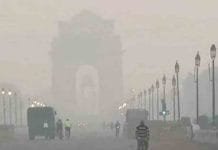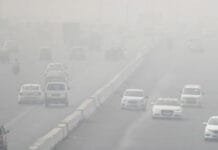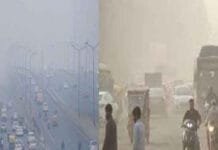The southwest monsoon is progressing steadily, bringing relief and anticipation across various regions in India. Having already reached Madhya Pradesh, Chhattisgarh, Odisha, Jharkhand, West Bengal, and Bihar, the monsoon’s advance remains favorable for further progression in these states. In the coming days, the remaining parts of Maharashtra and some areas of eastern Uttar Pradesh are also expected to experience the onset of monsoon. Additionally, heavy pre-monsoon rains are forecasted for parts of Uttarakhand and eastern Uttar Pradesh starting Monday.
IMD’s Forecast: Monsoon Advancing at Normal Pace
According to the India Meteorological Department (IMD), the monsoon is moving at a normal pace towards its northern boundary. Within the next 5-6 days, the monsoon will envelop the entire Uttar Pradesh. States like Delhi, Punjab, and Haryana are anticipated to receive monsoon rains by the scheduled date of 27-28 June. Currently, heavy rains are recorded at isolated places in Sikkim, Jharkhand, Odisha, Madhya Pradesh, Chhattisgarh, and Sub-Himalayan West Bengal.
Himachal Pradesh: Rain Forecast from 26th June
The monsoon is projected to arrive in Himachal Pradesh by 28th June. From 26th June, rains will commence in many parts of the state, although the weather is expected to remain inclement in several areas on Sunday. Sunshine is predicted for the 24th and 25th of June, providing a brief respite before the onset of rain.
Rain in Lahaul-Spiti, Snow in Rohtang
The lower areas of the tribal district Lahaul-Spiti experienced rain on Saturday. Meanwhile, snowfall on the high peaks including Rohtang has ushered in colder conditions. However, Kullu has not received rain for the third consecutive day, leaving farmers disheartened due to the persistent cloud cover but no precipitation.
Heat Alert in North India
Delhi-NCR enjoyed some relief from the intense heat on Saturday owing to cloudy skies. However, the plains of North India, including western Uttar Pradesh, are expected to endure severe heat for two more days. According to the IMD, a heatwave is likely to persist in parts of western Uttar Pradesh until June 25. On June 24 and 25, Punjab, Haryana, Chandigarh-Delhi may also experience heatwave conditions. Post these dates, relief from the extreme heat is anticipated.
Impact on Agriculture and Daily Life
The monsoon’s progress is crucial for the agricultural sector, as timely rains are essential for sowing and crop growth. Farmers in regions awaiting the monsoon are preparing their fields, hopeful for a bountiful season ahead. In areas like Kullu, the delay in rain is causing concern among farmers, highlighting the delicate balance required for successful farming.
Monsoon Coverage in Other States
Madhya Pradesh and Chhattisgarh
Monsoon rains have brought much-needed respite to Madhya Pradesh and Chhattisgarh. These states are experiencing substantial rainfall, rejuvenating the parched lands and filling reservoirs and rivers. The rains are expected to continue, ensuring adequate water supply for both agricultural and domestic use.
Odisha and Jharkhand
In Odisha and Jharkhand, the monsoon has also made significant progress. Heavy rains are refreshing the landscape, and the agricultural activities are in full swing. The continuous rain is expected to support the cultivation of staple crops such as rice, which is heavily dependent on monsoon showers.
West Bengal and Bihar
West Bengal and Bihar are also witnessing consistent monsoon activity. These states, prone to both floods and droughts, rely heavily on a balanced monsoon season. The current rains are beneficial, although authorities remain vigilant about potential flooding in low-lying areas.
Weather Patterns and Climate Observations
Sub-Himalayan West Bengal and Sikkim
Heavy rains are currently affecting Sub-Himalayan West Bengal and Sikkim, regions known for their unique climate patterns. The monsoon brings lush greenery and replenishes water sources, vital for both local ecosystems and human settlements.
Weather Impact on Tourism and Travel
The monsoon season significantly influences tourism in India. While some regions become more attractive due to the scenic beauty enhanced by rains, others may face challenges such as landslides and flooding. Travelers to monsoon-affected areas are advised to stay updated with weather forecasts and plan their journeys accordingly.
Safety Precautions and Preparedness
Flood and Landslide Preparedness
With the monsoon bringing heavy rains, the risk of floods and landslides increases in several regions. Authorities are on high alert, and residents in vulnerable areas are advised to take necessary precautions. It’s crucial to stay informed through weather updates and follow guidelines issued by local administrations.
Health and Hygiene During Monsoon
Monsoon season also brings about an increase in waterborne diseases. Proper sanitation and hygiene practices are essential to prevent illnesses such as dengue, malaria, and cholera. Public health officials recommend using mosquito repellents, ensuring clean drinking water, and maintaining overall cleanliness to mitigate health risks.
Future Projections and Long-Term Outlook
The monsoon’s advance is a critical period for weather scientists and agricultural planners. Continuous monitoring and accurate forecasting are vital for minimizing the adverse impacts of extreme weather events. Long-term climate models suggest variability in monsoon patterns, emphasizing the need for adaptive strategies in both agriculture and urban planning.
Technological Advances in Weather Forecasting
Recent advancements in weather forecasting technology have improved the accuracy of monsoon predictions. Satellite imagery, computer models, and real-time data collection allow meteorologists to provide timely and precise forecasts. These innovations are crucial for effective disaster management and resource planning.
Community and Government Initiatives
Community awareness programs and government initiatives play a pivotal role in preparing for the monsoon season. Educational campaigns on emergency preparedness, coupled with infrastructural improvements such as flood defenses and better drainage systems, can significantly reduce the impact of heavy rains.
The monsoon season, with its complex interplay of benefits and challenges, remains a defining feature of life in India. As the monsoon progresses towards Delhi and other northern states by the end of June, careful planning and proactive measures are essential. From agricultural productivity to urban living, the monsoon’s influence is profound, demanding a coordinated response to harness its benefits while mitigating potential risks.














